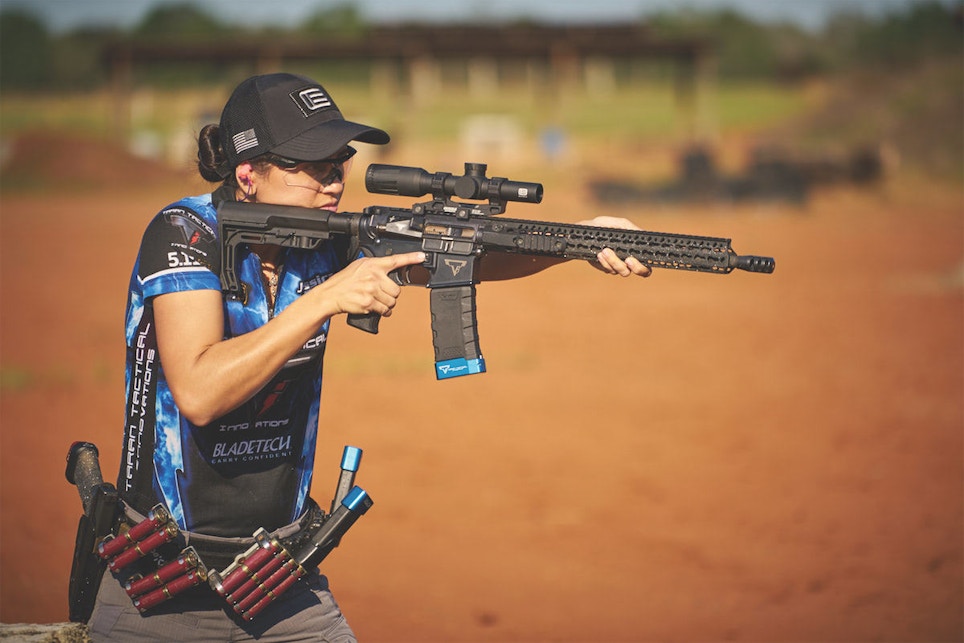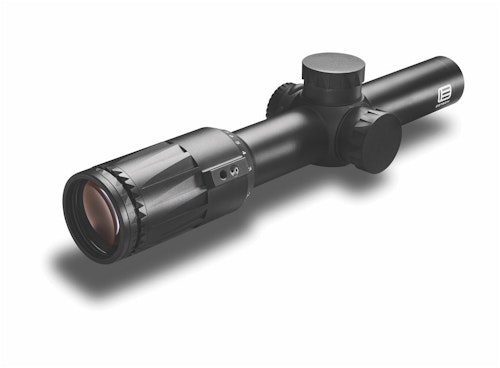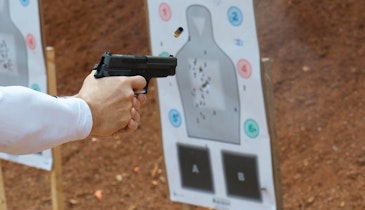EOTECH is probably best known for its Holographic Weapon Sights, which have been designed and built in Ann Arbor, Michigan, since 1996. But the company also manufactures professional-grade hybrid sights, magnifiers, riflescopes, and thermal and night vision, and it entered the very competitive market of variable-powered riflescopes in 2016 with the introduction of its Vudu lineup.
Shooting Sports Retailer recently caught up with John Bailey, VP of marketing and product management, to learn about EOTECH’s history, its current lineup of top-notch sights for hunting, and the company’s plan as shooters and hunters hope to put the pandemic in the rearview mirror.
SSR: Your company has an interesting history, which began on a college campus, correct?
Bailey: That’s right. Holography goes way back to the 1940s with some scientists at the University of Michigan approaching the U.S. Air Force with a research proposal. As technology advanced, holographic prototypes were demonstrated for use in helicopter gun-ships. It wasn’t until the mid 1990s when the process and parts miniaturized to a point where it was realistic to develop something for small arms. EOTECH was formed and spun off from the Environmental Research Institute of Michigan to become an independent business. The first generation of holographic sight was developed. Shortly after its initial introduction, EOTECH actually developed and launched an archery sight, as well, with some really cool three-dimensional reticles.
SSR: Like many new hunting and shooting products, EOTECH introduced its HWS at the SHOT Show. How was it received by the outdoor industry?
Bailey: Back when we produced the first holographic sight for use on a firearm, EOTECH wasn’t a brand or recognizable name in the industry. To get the best traction on this new technology, we licensed the product to Bushnell and called it the Holosight. Bushnell introduced it at the 1996 SHOT Show, and the sight won the Optic of the Year award. Bushnell certainly helped validate the technology and generate initial demand, but it wasn’t until the Holosight was shown to a few U.S. Special Forces guys that the demand really took off. SF saw its speed to target, versatility and two-eyes-open shooting benefits and reached out to EOTECH to develop a ruggedized, military version. This is where the addition of the aluminum hood, brightness settings specific for night-vision use, better waterproofing, and 1913 rail compatibility were added, making it a robust, dependable combat optic. This put EOTECH on the map.
SSR: There’s a great deal of confusion among many hunters between holographic sights and red-dot sights. What’s the difference?
Bailey: The EOTECH HWS is often lumped into the category of red-dots. It is true that it does have a red dot, but the differences between red-dot technology and holographic technology are many.
First, red-dot sights are simple in design. They consist of an LED light positioned at the rear of the sight that is aimed at the front lens. The lens has filters that bounce or reflect the red light back to the user in the form of a dot. One limitation is that the dot needs to be big enough for the user to find quickly and align with their target, but small enough that it doesn’t obscure the target and reduce accuracy. Holography overcomes this compromise. EOTECH can incorporate any reticle design to include things like stadia lines, ballistic holds and range estimation. The most common reticle, known at times as the “doughnut of death,” is a 68-MOA ring with a 1-MOA aiming dot. Because the HWS is powered by a laser diode and not an LED, the aiming dot is a true point source and offers the smallest dot in the industry. Here you have a large reference ring to get you on target quickly, but a very precise aiming dot to provide the best accuracy.
A major limitation for red-dots is that the dot is at a different focal plane than your target. This causes the user to shift their focus slightly to focus on the dot and then shift back to the target. An HWS reticle is focused at the target plane so you don’t have to shift your focus. You maintain your target focus and see your reticle clearly.
Another advantage the HWS has is that it is not dependent on the front glass for the reticle. In fact, if the user were to experience a catastrophic incident where the front glass was to break or be damaged, the sight would still work and maintain zero. Further, the back glass, where the reticle is captured, can also be broken and the user will still be able to see and use the reticle in the remaining pieces of glass. Red-dots are dependent on their front glass to reflect the dot back to your eye, and if damaged or broken, the dot may not be seen nor zero maintained.
Lastly, there several other advantages like square window for better field of view, common battery options, an integrate mounting base that removes the need for a mount, and that the HWS is 100% made in the U.S.A.
SSR: For two decades, your HWS has been chosen by U.S. Special Operations, elite Army units and the U.S. Marine Corps as their preferred close-quarter combat optic of choice. Why do you think it’s the top choice?
Bailey: There isn’t just one reason. All of these military units tested EOTECH products as well as several other red-dots. The EOTECH HWS was proven to be faster to target, faster for follow-up shots, and to have a wider field of view — three things that make them better at what they do. Also, the small aiming dot gives them more accuracy and less target obscurity, and the 68-MOA ring around the dot not only gave them crude range estimation capabilities, but the bottom of the ring provided an up-close-and-personal aiming point for indoor, CQB engagements.
SSR: Do the reasons why the HWS excels in close-quarter combat translate into the field for hunters, specifically those pursuing turkeys and predators?
Bailey: Absolutely. All of the benefits military and LE operators take advantage of translate directly to other shooting disciplines like competitive, recreational and hunting. Our small aiming dot gives them the most accuracy for a nonmagnified optic. The ring gets them onto the target faster. But when it comes to turkey and predator hunting, the HWS is hard to beat. For turkeys, a huge advantage is that the 68-MOA ring represents their shotgun shot pattern. Put the turkey’s head in the ring, and pull the trigger. It is that easy.
For predator hunting, magnified riflescopes might be the better tool for certain situations, but the HWS, especially when used with our 3X (G43) or 5X (G45) magnifier, can provide both medium- and close-range shooting by simply pushing the magnifier out of the way. The 1-MOA aiming dot is ideal for smaller targets like coyotes, fox and bobcats.
The HWS aiming dot does not grow when you view it through magnification. Because it is a true point source, the dot size doesn’t change, while the target grows 3X or 5X. This gives the hunter added accuracy in placing the perfect shot. This is not true for traditional red-dots; the dot will grow at the same rate as the target, so there isn’t as big of an advantage.
SSR: EOTECH entered the very competitive market of variable-powered riflescopes in 2016 with the introduction of its Vudu lineup. What should hunters know about Vudu riflescopes?
Bailey: The Vudu line of riflescopes was designed for the hunter or shooter who won’t compromise on quality, performance and clarity. Vudu scopes offer several features such as zero-stop turrets, a one-piece fluid eyepiece for easy manipulation throughout the magnification range, and reticle illumination through either etched reticles or wired fiber-optic dots, as well as reticles designed for all disciplines. The clarity of the glass and the scope’s light-gathering capabilities are common compliments we receive on these scopes. I don’t think any hunter would be disappointed with these scopes on their once-in-a-lifetime hunt.
SSR: EOTECH offers similar size/magnifications in its Vudu lineup in both FFP (first focal plane) and SFP (second focal plane) options. Do your retailers stock both versions, or do SFP models dominate their sales?
Bailey: Our retailers have been known to carry both SFP and FFP Vudu scopes. This might be because they cater to other types of shooters, but most hunters do prefer our second focal plane offerings. This is primarily because they like to keep the fine crosshair or dot throughout the magnification range for more precise shot placement. In addition, most long-range hunters will be equipped with a laser rangefinder to determine distance to target, so the range estimation capability throughout an FFP magnification range is less important to them.
SSR: In 2005, EOTECH was acquired by defense contractor L-3 Communications (now called L3Harris), but in 2020, it once again became a stand-alone company. What are the advantages of being an independent business?
Bailey: When EOTECH was acquired by L-3, it immediately benefited from an infusion of money that helped grow the brand and meet increasing demands. But with that came a lot of corporate bureaucracy, red tape and multiple levels for decisions. This really slowed us down, and on top of that, EOTECH was the only commercial product and company in their portfolio, so we were often misunderstood or overlooked. Now that we are independent again, we removed the corporate stiffs and built a team that included many past EOTECH employees who were key to the company’s initial success, along with other like-minded, proactive, eager individuals interested in building EOTECH back to greatness. Product development, investment, budget and marketing decisions are now all made inside the building. Areas like speed to market, communications to our channels, international licensing and customer service have all improved since our Independence Day.
SSR: Dealers have a lot of brands from which to choose when it comes to variable-powered riflescopes. What sets EOTECH apart from its competition in regard to dealer support?
Bailey: I think dealers know that any product EOTECH launches is of the highest quality and is extremely dependable. We don’t compromise on components, features, warranty or customer service. We also offer our dealers support through advertising co-op, promotional support, MAP pricing to preserve their margins, and even a range program that provides EOTECH products for their demo guns. Our goal is to make it easy to deal with EOTECH. We want to build long-lasting partners so margins, on-time deliveries, marketing support and immediate response times are all important to build that trust.








